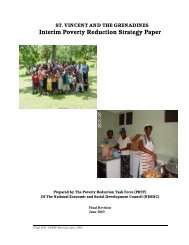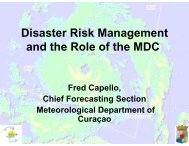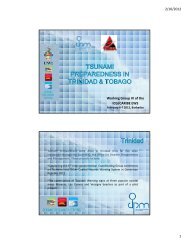The Anatomy of A Silent Crisis The Anatomy of A Silent Crisis
The Anatomy of A Silent Crisis The Anatomy of A Silent Crisis
The Anatomy of A Silent Crisis The Anatomy of A Silent Crisis
- TAGS
- anatomy
- www.bb.undp.org
You also want an ePaper? Increase the reach of your titles
YUMPU automatically turns print PDFs into web optimized ePapers that Google loves.
100 Forum 2009: Climate Change – <strong>The</strong> <strong>Anatomy</strong> <strong>of</strong> a <strong>Silent</strong> <strong>Crisis</strong><br />
56. Based on the geographical representation in the Stern<br />
model. <strong>The</strong> model does not give results for 2030. We use<br />
the mean value for 2020 and project it linearly to 203<br />
57. CIA World Factbook Database, (2007).<br />
58. European Commission. (2008): “Financial Programming<br />
and Budget.” European Commission. http://ec.europa.<br />
eu/budget/budget_detail/current_year_en.htm.<br />
59. Based on updated Stern Report PAGE 2002 model,<br />
the mean value is 1.3 trillion. <strong>The</strong> range <strong>of</strong> the 90%<br />
confidence interval is US $300 to US $3450 billion. See<br />
“Notes on report methodology D.” for further description.<br />
60. Inman, M. (2008). “Carbon is forever”. Nature<br />
Reports Climate Change. http://www.nature.com/<br />
climate/2008/0812/full/climate.2008.122.html<br />
61. Based on updated Stern Report PAGE 2002 model —<br />
the model calculates a SCC <strong>of</strong> $10 - $115, with a mean<br />
value <strong>of</strong> $45 per tonne <strong>of</strong> CO2. See “Notes on report<br />
methodology D.” for further description.<br />
62. Nicholls, R.J., et al. (2007): “Coastal systems and<br />
low-lying areas.” Climate Change 2007: Impacts,<br />
Adaptations and Vulnerability, Contribution <strong>of</strong><br />
Working Group II to the Fourth Assessment Report<br />
<strong>of</strong> the Intergovernmental Panel on Climate Change,<br />
M.L. Parry, et al. Eds., Cambridge University Press,<br />
Cambridge, UK, Chapter 6 Box 6.4.<br />
63. Wilbanks, T.J., et al. (2007) “Industry, settlement<br />
and society.” Climate Change 2007: Impacts,<br />
Adaptations and Vulnerability, Contribution <strong>of</strong><br />
Working Group II to the Fourth Assessment Report<br />
<strong>of</strong> the Intergovernmental Panel on Climate Change,<br />
M.L. Parry, et al. Eds., Cambridge University Press,<br />
Cambridge, UK, Chapter 7 Box 7.4.<br />
64. Munich Re Statistics, (2009).<br />
65. Bernstein, L., et al. (2007). “Climate Change 2007:<br />
Synthesis Report — Summary for Policymakers.”<br />
Fourth Assessment Report <strong>of</strong> the Intergovernmental<br />
Panel on Climate Change.<br />
66. Parry, M.L. (2007): “<strong>The</strong> impacts <strong>of</strong> climate change<br />
for crop yields, global food supply and risk <strong>of</strong> hunger.”<br />
ICRISAT, December, Volume 4, Issue 1, p.12.<br />
http://www.icrisat.cgiar.org/Journal/SpecialProject/<br />
sp14.pdf.<br />
67. Easterling, W.E., et al. (2007): “Food, fibre and<br />
forest products.” Climate Change 2007: Impacts,<br />
Adaptations and Vulnerability, Contribution <strong>of</strong><br />
Working Group II to the Fourth Assessment Report<br />
<strong>of</strong> the Intergovernmental Panel on Climate Change,<br />
M.L. Parry, et al. Eds., Cambridge University Press,<br />
Cambridge, UK, 273-313.<br />
68. Erda, L., et al. (2009): “Climate change and food<br />
security in China.” <strong>The</strong> Chinese Academy <strong>of</strong><br />
Agricultural Science and Greenpeace China.<br />
69. Fischer, G., et al. (2005): “Socio-economic and<br />
climate change impacts on agriculture: an integrated<br />
assessment, 1990-2080.” Philosophical Transactions<br />
<strong>of</strong> the Royal Society, 360, 2067-2083, p2079.<br />
70. Assumes global population equals 6.76 billion.<br />
71. Diouf, J. (2009): “Food Security for All.” Food and<br />
Agriculture Organization <strong>of</strong> the United Nations High-<br />
Level Meeting, January 26-27, Madrid. http://www.fao.<br />
org/english/dg/2009/2627january2009.html.<br />
72. World Food Programme estimates that 963 million are<br />
hungry today; 907 million <strong>of</strong> which live in developing<br />
nations, (565 million are in Asia and the Pacific, 230<br />
million in Sub-Saharan Africa, 58.4 million in Latin<br />
America and the Caribbean, 41.6 million in the Near<br />
East and North Africa, etc).<br />
73. WFP. (2009): “Who are the hungry?” World Food<br />
Programme. http://www.wfp.org/hunger/who-are.<br />
74. IFPRI (2004): “Ending hunger in Africa prospects for<br />
the small farmer.” International Food Policy Research<br />
Institute. http://www.ifpri.org/pubs/ib/ib16.pdf.<br />
75. Please refer to “Notes on report methodology C.”<br />
For similar results, also see: Easterling, W.E., et al.<br />
(2007): “Food, fibre and forest products.” Climate<br />
Change 2007: Impacts, Adaptations and Vulnerability,<br />
Contribution <strong>of</strong> Working Group II to the Fourth<br />
Assessment Report <strong>of</strong> the Intergovernmental Panel on<br />
Climate Change, M.L. Parry, et al. Eds., Cambridge







